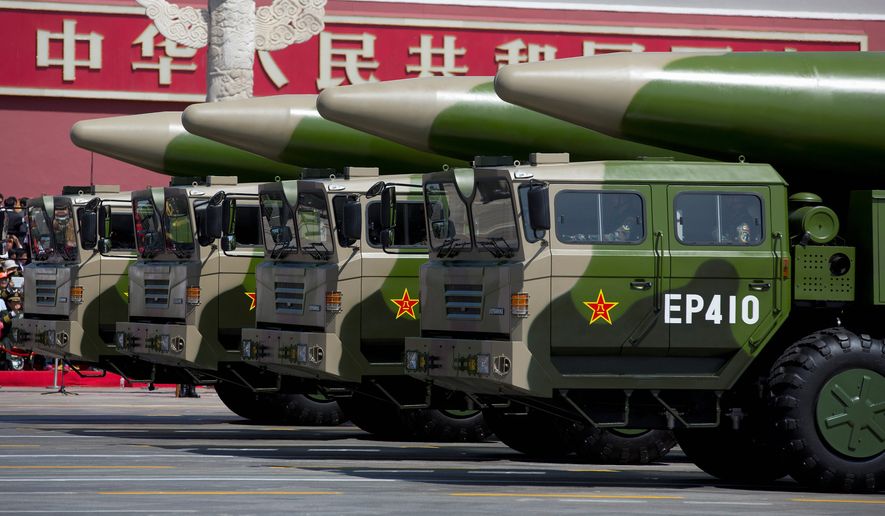A version of this story appeared in the daily Threat Status newsletter from The Washington Times. Click here to receive Threat Status delivered directly to your inbox each weekday.
China now boasts the world’s largest arsenal of hypersonic missiles, which can hit U.S. targets with both nuclear and conventional warheads, a senior U.S. intelligence analyst told Congress on Tuesday.
Russia also has deployed three types of the ultra-high-speed maneuvering weapons that also can be equipped with either nuclear or conventional warheads and fired the first hypersonic weapon in combat against civilians in Ukraine, senior defense and military officials testified during a House Armed Services subcommittee hearing.
The advances have fueled fears that the U.S. has fallen behind its two most potent adversaries in a critical facet of the modern arms race.
Despite the dual-use advanced missile threats, Pentagon officials told the House panel’s strategic forces subcommittee that the U.S. has no plans to equip its planned future hypersonic missiles with nuclear warheads, over concerns that such weapons would prove strategically destabilizing.
The hearing on hypersonic missiles revealed that several recent U.S. test failures have left the Pentagon scrambling to catch up to China and Russia in developing and deploying new high-speed missiles that travel faster than Mach 5, or five times the speed of sound.
Jeffrey McCormick, an intelligence analyst with the Defense Intelligence Agency’s National Air and Space Intelligence Center, said China “dramatically” tested and built hypersonic missiles over the past two decades for both nuclear and conventional strike systems against the U.S. and now has “the world’s leading hypersonic arsenal.”
Beijing’s most lethal hypersonic missile is the DF 17, deployed in 2020 and which can travel at least 994 miles, “enabling it to reach U.S. military basing and fleet assets in western Pacific,” he said.
Since 2014, China’s military has conducted multiple tests of intercontinental range hypersonic missiles, including the July 2021 flight test of an orbiting hypersonic weapon.
“China’s investments will enable it to deploy large numbers of hypersonic missiles in line with its plans for building ‘a strong and modernized rocket force,’” Mr. McCormack said.
U.S. military officials told the hearing that the Pentagon is speeding up work on hypersonic missiles that can be fired from aircraft, ground launchers, destroyers and submarines. However, several test failures have set back the high priority, multibillion-dollar weapon program.
“We’ve had some hiccups, and we’re learning from that,” said Vice Adm. Johnny R. Wolfe Jr., director of the Navy’s strategic systems program.
Subcommittee Chair Doug Lamborn said U.S. hypersonic missile development is “one of the most pressing issues for our national defense.”
“China and Russia continue their own program developments at a breathtaking pace,” the Colorado Republican said.
Mr. Lamborn said the joint Army and Navy missile program suffered several test failures, and the Air Force is struggling with its air-launched rapid response weapon, or ARRW. The military is working to identify and fix the malfunctions and return the programs to flight testing, he said.
“However, at this point we are still well behind our adversaries even if everything goes as planned,” Mr. Lamborn said.
Skimming the atmosphere
The missiles are fired on rocket boosters and then released as gliders that skim the upper atmosphere using precision guidance to frustrate missile defense systems and strike targets with high accuracy. Hypersonic missiles are said to be capable of hitting targets at any location on Earth in 30 minutes or less.
Russia’s hypersonic missiles include the air-launched “Kinzhal” which can travel at a speed of Mach 10 with a range of 1,232 miles. Mr. McCormack said the Kinzhals have been used extensively in the war in Ukraine, with varying degrees of effectiveness.
Lawmakers on Tuesday pressed the defense and military witnesses to say whether the United States would build a nuclear-tipped version for future hypersonic missiles. All current systems will be conventionally armed, the Pentagon says.
Rep. Don Bacon, Nebraska Republican, questioned the policy of limiting U.S. hypersonic missiles to conventional warheads. “If Russia and China are putting nuclear warheads on hypersonic delivery systems, why is it that we’re not?” he asked.
Michael C. Horowitz, deputy assistant defense secretary for force development in the Pentagon’s policy office, said the use of non-nuclear warheads is based on the assessment that current strategic forces — missiles, bombers and submarines — are sufficient to deter an adversary.
“The department’s offensive hypersonic weapons development is driven by a need to provide a full range of options to senior decision makers,” Mr. Horowitz said. “Hypersonics are a key component in the mix of capabilities that the joint force needs to deter, and if necessary, defeat aggression.”
Mr. Lamborn, the subcommittee chairman, said hypersonic missiles are needed in the Indo-Pacific to counter China’s missiles.
“They enable us to strike distant, defended, and time-critical threats that other forces cannot,” he said. “Let’s be clear, China and Russia have the advantage when it comes to hypersonic capabilities. … We must act now to get these programs on track before the U.S. falls further behind our adversaries.”
• Bill Gertz can be reached at bgertz@washingtontimes.com.




Please read our comment policy before commenting.